 Click image for description | ||||||||||
| Orbital characteristics | ||||||||||
|---|---|---|---|---|---|---|---|---|---|---|
| Epoch J2000 | ||||||||||
| Aphelion | 108,942,109 km 0.72823128 AU | |||||||||
| Perihelion: | 107,476,259 km 0.71843270 AU | |||||||||
| Semi-major axis: | 108,208,930 km 0.723332 AU | |||||||||
| Eccentricity: | 0.0068 | |||||||||
| Orbital period: | 224.70069 day 0.6151970 yr | |||||||||
| Synodic period: | 583.92 day | |||||||||
| Avg. orbital speed: | 35.02 km/s | |||||||||
| Inclination: | 3.39471° 3.86° to Sun's equator | |||||||||
| Longitude of ascending node: | 76.67069° | |||||||||
| Argument of perihelion: | 54.85229° | |||||||||
| Satellites: | None | |||||||||
| Physical characteristics | ||||||||||
| Mean radius: | 6051.8 ± 1.0 km[1] 0.9499 Earths | |||||||||
| Flattening: | < id="_ref-Seidelmann2007_1" class="reference">[1] | |||||||||
| Surface area: | 4.60×108 km² 0.902 Earths | |||||||||
| Volume: | 9.38×1011 km³ 0.857 Earths | |||||||||
| Mass: | 4.8685×1024 kg 0.815 Earths | |||||||||
| Mean density: | 5.204 g/cm³ | |||||||||
| Equatorial surface gravity: | 8.87 m/s2 0.904 g | |||||||||
| Escape velocity: | 10.46 km/s | |||||||||
| Sidereal rotation period: | −243.0185 day | |||||||||
| Rotation velocity at equator: | 6.52 km/h | |||||||||
| Axial tilt: | 177.36° | |||||||||
| Right ascension of North pole: | 18 h 11 min 2 s 272.76°[2] | |||||||||
| Declination of North pole: | 67.16° | |||||||||
| Albedo: | 0.65 | |||||||||
| Surface temp.: Kelvin Celsius |
| |||||||||
| Apparent magnitude: | up to -4.6[3] | |||||||||
| Angular size: | 9.7" — 66.0"[3] | |||||||||
| Adjectives: | Venusian or (rarely) Cytherean | |||||||||
| Atmosphere | ||||||||||
| Surface pressure: | 9.3 MPa | |||||||||
| Composition: | ~96.5% Carbon dioxide ~3.5% Nitrogen .015% Sulphur dioxide .007% Argon .002% Water vapor .0017% Carbon monoxide .0012% Helium .0007% Neon trace Carbonyl sulfide trace Hydrogen chloride trace Hydrogen fluoride | |||||||||
Venus (pronounced /ˈviːnəs/) is the second-closest planet to the Sun, orbiting it every 224.7 Earth days. It is the brightest natural object in the night sky, except for the Moon, reaching an apparent magnitude of −4.6. Because Venus is an inferior planet, from Earth it never appears to venture far from the Sun: its elongation reaches a maximum of 47.8°. Venus reaches its maximum brightness shortly before sunrise or shortly after sunset, for which reason it is often called the Morning Star or the Evening Star.
Classified as a terrestrial planet, it is sometimes called Earth's "sister planet", for the two are similar in size, gravity, and bulk composition. Venus is covered with an opaque layer of highly reflective clouds of sulfuric acid, preventing its surface from being seen from space in visible light; this was a subject of great speculation until some of its secrets were revealed by planetary science in the twentieth century. Venus has the densest atmosphere of all the terrestrial planets, consisting mostly of carbon dioxide, as it has no carbon cycle to lock carbon back into rocks and surface features, nor organic life to absorb it in biomass. It has become so hot that the earth-like oceans the young Venus is believed to have possessed have totally evaporated, leaving a dusty dry desertscape with many slab-like rocks. The evaporated water vapor has dissociated and hydrogen has escaped into interplanetary space. The atmospheric pressure at the planet's surface is 92 times that of the Earth, the great majority of it carbon dioxide and other greenhouse gases.
Venus's surface has been mapped in detail only in the last 20 years (Project Magellan) which listed about a thousand meteor craters, a surprisingly low number compared to Earth. It shows evidence of being geologically very young with extensive volcanism, and the sulfur in the atmosphere is taken by some experts to show many of its volcanoes are still active today, but it is an enigma as to why no evidence of lava flow accompanies any of the visible caldera.
The adjective Venusian is commonly used for items related to Venus, though the Latin adjective is the rarely used Venerean; the now-archaic Cytherean is still occasionally encountered. Venus is the only planet in the Solar System named after a female figure,[6] although two dwarf planets—Ceres and Eris—also have female names.
Venus is thought to undergo periodic episodes of plate tectonics, in which the crust is subducted rapidly within a few million years, separated by periods of a few hundred million years of relative stability. This contrasts strongly with Earth's more or less steady state of ongoing subduction and continential drift, but the venusian behavior corresponds well with Earth modeled then changed by removing the lubricant—the oceans. It is believed the surface rocks of Venus are only about a half-a-billion years old as impact crater analysis suggests that its surface dynamics have exchanged its surface for a clean face (wiping out old craters) sometime in the last billion years.
Contents[hide] |
[edit] Structure
Venus is one of the four solar terrestrial planets, meaning that, like the Earth, it is a rocky body. In size and mass, it is very similar to the Earth, and is often described as its 'twin'. The diameter of Venus is only 650 km less than the Earth's, and its mass is 81.5% of the Earth's. However, conditions on the Venusian surface differ radically from those on Earth, due to its dense carbon dioxide atmosphere. The mass of the atmosphere of Venus is 96.5% carbon dioxide, with most of the remaining 3.5% composed of nitrogen.[7]
[edit] Internal structure
Though there is little direct information about its internal structure, the similarity in size and density between Venus and Earth suggests that it has a similar internal structure: a core, mantle, and crust. Like that of Earth, the Venusian core is at least partially liquid. The slightly smaller size of Venus suggests that pressures are significantly lower in its deep interior than Earth. The principal difference between the two planets is the lack of plate tectonics on Venus, likely due to the dry surface and mantle. This results in reduced heat loss from the planet, preventing it from cooling and providing a likely explanation for its lack of an internally generated magnetic field.[8]
[edit] Geography
About 80% of Venus's surface consists of smooth volcanic plains. Two highland 'continents' make up the rest of its surface area, one lying in the planet's northern hemisphere and the other just south of the equator. The northern continent is called Ishtar Terra, after Ishtar, the Babylonian goddess of love, and is about the size of Australia. Maxwell Montes, the highest mountain on Venus, lies on Ishtar Terra. Its peak is 11 km above Venus's average surface elevation. The southern continent is called Aphrodite Terra, after the Greek goddess of love, and is the larger of the two highland regions at roughly the size of South America. Much of this continent is covered by a network of fractures and faults.[9]
As well as the impact craters, mountains, and valleys commonly found on rocky planets, Venus has a number of unique surface features. Among these are flat-topped volcanic features called farra, which look somewhat like pancakes and range in size from 20–50 km across, and 100–1000 m high; radial, star-like fracture systems called novae; features with both radial and concentric fractures resembling spiders' webs, known as arachnoids; and coronae, circular rings of fractures sometimes surrounded by a depression. All of these features are volcanic in origin.[10]
Almost all Venusian surface features are named after historical and mythological women.[11] The only exceptions are Maxwell Montes, named after James Clerk Maxwell, and two highland regions, Alpha Regio and Beta Regio. These three features were named before the current system was adopted by the International Astronomical Union, the body that oversees planetary nomenclature.[12]
[edit] Surface geology
Much of Venus's surface appears to have been shaped by volcanic activity. Overall, Venus has several times as many volcanoes as Earth, and it possesses some 167 giant volcanoes that are over 100 km across. The only volcanic complex of this size on Earth is the Big Island of Hawaii. However, this is not because Venus is more volcanically active than Earth, but because its crust is older. Earth's crust is continually recycled by subduction at the boundaries of tectonic plates, and has an average age of about 100 million years, while Venus's surface is estimated to be about 500 million years old.[10]
Several lines of evidence point to ongoing volcanic activity on Venus. During the Russian Venera program, the Venera 11 and Venera 12 probes detected a constant stream of lightning, and Venera 12 recorded a powerful clap of thunder soon after it landed. While rainfall drives thunderstorms on Earth, there is no rainfall on Venus. One possibility is that ash from a volcanic eruption was generating the lightning. Another intriguing piece of evidence comes from measurements of sulfur dioxide concentrations in the atmosphere, which were found to drop by a factor of 10 between 1978 and 1986. This may imply that the levels had earlier been boosted by a large volcanic eruption.[13]
There are almost 1,000 impact craters on Venus, more or less evenly distributed across its surface. On other cratered bodies, such as the Earth and the Moon, craters show a range of states of erosion, indicating a continual process of degradation. On the Moon, degradation is caused by subsequent impacts, while on Earth, it is caused by wind and rain erosion. However, on Venus, about 85% of craters are in pristine condition. The number of craters together with their well-preserved condition indicates that the planet underwent a total resurfacing event about 500 million years ago.[14] Earth's crust is in continuous motion, but it is thought that Venus cannot sustain such a process. Without plate tectonics to dissipate heat from its mantle, Venus instead undergoes a cyclical process in which mantle temperatures rise until they reach a critical level that weakens the crust. Then, over a period of about 100 million years, subduction occurs on an enormous scale, completely recycling the crust.[10]
Venusian craters range from 3 km to 280 km in diameter. There are no craters smaller than 3 km, because of the effects of the dense atmosphere on incoming objects. Objects with less than a certain kinetic energy are slowed down so much by the atmosphere that they do not create an impact crater.[15]
[edit] Atmosphere
Venus has an extremely thick atmosphere, which consists mainly of carbon dioxide and a small amount of nitrogen. The atmospheric mass is 93 times that of Earth's atmosphere while the pressure at the planet's surface is about 92 times that at Earth's surface—a pressure equivalent to that at a depth of nearly 1 kilometer under Earth's oceans. The density at the surface is 65 kg/m³ (6.5% that of water). The enormously CO2-rich atmosphere, along with thick clouds of sulfur dioxide, generates the strongest greenhouse effect in the solar system, creating surface temperatures of over 460 °C.[16] This makes Venus's surface hotter than Mercury's, even though Venus is nearly twice Mercury's distance from the Sun and receives only 25% of Mercury's solar irradiance. Because of the lack of any moisture on Venus, there is no relative humidity on the surface, creating a heat index of 450 °C to 480 °C.
Studies have suggested that several billion years ago Venus's atmosphere was much more like Earth's than it is now, and that there were probably substantial quantities of liquid water on the surface, but a runaway greenhouse effect was caused by the evaporation of that original water, which generated a critical level of greenhouse gases in its atmosphere.[17] Thermal inertia and the transfer of heat by winds in the lower atmosphere mean that the temperature of Venus's surface does not vary significantly between the night and day sides, despite the planet's extremely slow rotation. Winds at the surface are slow, moving at a few kilometers per hour, but because of the high density of the atmosphere at Venus's surface, they exert a significant amount of force against obstructions, and transport dust and small stones across the surface. This would make it difficult for a human to walk through.[18] Above the dense CO2 layer are thick clouds consisting mainly of sulfur dioxide and sulfuric acid droplets.[19][20] These clouds reflect about 60% of the sunlight that falls on them back into space, and prevent the direct observation of Venus's surface in visible light. The permanent cloud cover means that although Venus is closer than Earth to the Sun, the Venusian surface is not as well heated or lit. In the absence of the greenhouse effect caused by the carbon dioxide in the atmosphere, the temperature at the surface of Venus would be quite similar to that on Earth. Strong 300 km/h winds at the cloud tops circle the planet about every four to five earth days.[21]
The surface of Venus is effectively isothermal; it retains a constant temperature between day and night and between the equator and the poles.[22][23] The planet's minute axial tilt (less than three degrees, compared with 23 degrees for Earth), also minimises seasonal temperature variation.[24] The only appreciable variation in temperature occurs with altitude. In 1995, the Magellan probe imaged a highly reflective substance at the tops of Venus's highest mountain peaks which bore a strong resemblance to terrestrial snow. This substance arguably formed from a similar process to snow, albeit at a far higher temperature. Too volatile to condense on the surface, it rose in gas form to cooler higher elevations, where it then fell as precipitation. The identity of this substance is not known with certainty, but speculation has ranged from elemental tellurium to galena (lead sulfide).[25]
[edit] Magnetic field and core
In 1980, The Pioneer Venus Orbiter found that Venus's magnetic field is both weaker and smaller (i.e. closer to the planet) than Earth's. What small magnetic field is present is induced by an interaction between the ionosphere and the solar wind,[26] rather than by an internal dynamo in the core like the one inside the Earth. Venus's magnetosphere is too weak to protect the atmosphere from cosmic radiation.
This lack of an intrinsic magnetic field at Venus was surprising given that it is similar to Earth in size, and was expected to also contain a dynamo in its core. A dynamo requires three things: a conducting liquid, rotation, and convection. The core is thought to be electrically conductive, however. Also, while its rotation is often thought to be too slow, simulations show that it is quite adequate to produce a dynamo.[27][28] This implies that the dynamo is missing because of a lack of convection in Venus's core. On Earth, convection occurs in the liquid outer layer of the core because the bottom of the liquid layer is much hotter than the top. Since Venus has no plate tectonics to let off heat, it is possible that it has no solid inner core, or that its core is not currently cooling, so that the entire liquid part of the core is at approximately the same temperature. Another possibility is that its core has already completely solidified.
[edit] Orbit and rotation
Venus orbits the Sun at an average distance of about 108 million km, and completes an orbit every 224.65 days. Although all planetary orbits are elliptical, Venus is the closest to circular, with an eccentricity of less than 1%. When Venus lies between the Earth and the Sun, a position known as 'inferior conjunction', it makes the closest approach to Earth of any planet, lying at a distance of about 40 million km. The planet reaches inferior conjunction every 584 days, on average.
Venus rotates once every 243 days—by far the slowest rotation period of any of the major planets. A Venusian sidereal day thus lasts more than a Venusian year (243 versus 224.7 Earth days). However, the length of a solar day on Venus is significantly shorter than the sidereal day; to an observer on the surface of Venus the time from one sunrise to the next would be 116.75 days.[29] The Sun would appear to rise in the west and set in the east. At the equator, Venus's surface rotates at 6.5 km/h; on Earth, the rotation speed at the equator is about 1,600 km/h.
If viewed from above the Sun's north pole, all of the planets are orbiting in a counter-clockwise direction; but while most planets also rotate counter-clockwise, Venus rotates clockwise in "retrograde" rotation. The question of how Venus came to have a slow, retrograde rotation was a major puzzle for scientists when the planet's rotation period was first measured. When it formed from the solar nebula, Venus would have had a much faster, prograde rotation, but calculations show that over billions of years, tidal effects on its dense atmosphere could have slowed down its initial rotation to the value seen today.[30][31]
A curious aspect of Venus's orbit and rotation periods is that the 584-day average interval between successive close approaches to the Earth is almost exactly equal to five Venusian solar days. Whether this relationship arose by chance or is the result of some kind of tidal locking with the Earth, is unknown.[32]
Venus is currently moonless, though the asteroid 2002 VE68 presently maintains a quasi-orbital relationship with it.[33] According to Alex Alemi and David Stevenson of the California Institute of Technology, their recent study of models of the early solar system shows that it is very likely that, billions of years ago, Venus had at least one moon, created by a huge impact event.[34][35] About 10 million years later, according to Alemi and Stevenson, another impact reversed the planet's spin direction. The reversed spin direction caused the Venusian moon to gradually spiral inward[36] until it collided and merged with Venus. If later impacts created moons, those moons also were absorbed the same way the first one was. The Alemi/Stevenson study is recent, and it remains to be seen what sort of acceptance it will achieve in the scientific community.
[edit] Observation

Venus is always brighter than the brightest stars, with its apparent magnitude ranging from −3.8 to −4.6. This is bright enough to be seen even in the middle of the day, and the planet can be easy to see when the Sun is low on the horizon. As an inferior planet, it always lies within about 47° of the Sun.[37]
Venus 'overtakes' the Earth every 584 days as it orbits the Sun. As it does so, it goes from being the 'Evening star', visible after sunset, to being the 'Morning star', visible before sunrise. While Mercury, the other inferior planet, reaches a maximum elongation of only 28° and is often difficult to discern in twilight, Venus is hard to miss when it is at its brightest. Its greater maximum elongation means it is visible in dark skies long after sunset. As the brightest point-like object in the sky, Venus is a commonly misreported 'unidentified flying object'. In 1973, future U.S. President Jimmy Carter reported having seen a UFO in 1969, which later analysis suggested was probably the planet, and countless other people have mistaken Venus for something more exotic.[38]
As it moves around its orbit, Venus displays phases like those of the Moon: it is new when it passes between the Earth and the Sun, full when it is on the opposite side of the Sun, and a half-phase when it is at its maximum elongations from the Sun. Venus is brightest when it is a thin crescent; it is much closer to Earth when a thin crescent than when gibbous, or full.
Venus's orbit is slightly inclined relative to the Earth's orbit; thus, when the planet passes between the Earth and the Sun, it usually does not cross the face of the Sun. However, transits of Venus do occur in pairs separated by eight years, at intervals of about 120 years, when the planet's inferior conjunction coincides with its presence in the plane of the Earth's orbit. The most recent transit was in 2004; the next will be in 2012. Historically, transits of Venus were important, because they allowed astronomers to directly determine the size of the astronomical unit, and hence of the solar system. Captain Cook's exploration of the east coast of Australia came after he had sailed to Tahiti in 1768 to observe a transit of Venus.
A long-standing mystery of Venus observations is the so-called Ashen light—an apparent weak illumination of the dark side of the planet, seen when the planet is in the crescent phase. The first claimed observation of ashen light was made as long ago as 1643, but the existence of the illumination has never been reliably confirmed. Observers have speculated that it may result from electrical activity in the Venusian atmosphere, but it may be illusory, resulting from the physiological effect of observing a very bright crescent-shaped object.[39]
| Venus transits the face of the Sun on June 8, 2004. |
[edit] Studies of Venus
[edit] Early studies
Venus was known in the Hindu Jyotisha since early times as the planet Shukra. In the West, before the advent of the telescope, Venus was known only as a 'wandering star'. Several cultures historically held its appearances as a morning and evening star to be those of two separate bodies. Pythagoras is usually credited with recognizing in the sixth century BC that the morning and evening stars were a single body, though he thought that Venus orbited the Earth. When Galileo first observed the planet in the early 17th century, he found that it showed phases like the Moon's, varying from crescent to gibbous to full and vice versa. This could be possible only if Venus orbited the Sun, and this was among the first observations to clearly contradict the Ptolemaic geocentric model that the solar system was concentric and centered on the Earth.[40]
Venus's atmosphere was discovered as early as 1790 by Johann Schröter. Schröter found that when the planet was a thin crescent, the cusps extended through more than 180°. He correctly surmised that this was due to scattering of sunlight in a dense atmosphere. Later, Chester Smith Lyman observed a complete ring around the dark side of the planet when it was at inferior conjunction, providing further evidence for an atmosphere.[41] The atmosphere complicated efforts to determine a rotation period for the planet, and observers such as Giovanni Cassini and Schröter incorrectly estimated periods of about 24 hours from the motions of markings on the planet's apparent surface.[42]
[edit] Ground-based research
Little more was discovered about Venus until the 20th century. Its almost featureless disc gave no hint as to what its surface might be like, and it was only with the development of spectroscopic, radar and ultraviolet observations that more of its secrets were revealed. The first UV observations were carried out in the 1920s, when Frank E. Ross found that UV photographs revealed considerable detail that was absent in visible and infrared radiation. He suggested that this was due to a very dense yellow lower atmosphere with high cirrus clouds above it.[43]
Spectroscopic observations in the 1900s gave the first clues about Venus's rotation. Vesto Slipher tried to measure the Doppler shift of light from Venus, but found that he could not detect any rotation. He surmised that the planet must have a much longer rotation period than had previously been thought.[44] Later work in the 1950s showed that the rotation was retrograde. Radar observations of Venus were first carried out in the 1960s, and provided the first measurements of the rotation period which were close to the modern value.[45]
Radar observations in the 1970s revealed details of Venus's surface for the first time. Pulses of radio waves were beamed at the planet using the 300 m radio telescope at Arecibo Observatory, and the echoes revealed two highly reflective regions, designated the Alpha and Beta regions. The observations also revealed a bright region attributed to mountains, which was called Maxwell Montes.[46] These three features are now the only ones on Venus which do not have female names.
The best radar images obtainable from Earth revealed features no smaller than about 5 km across. More detailed exploration of the planet could only be carried out from space.
[edit] Exploration of Venus
[edit] Early efforts
The first robotic space probe mission to Venus, and the first to any planet, began on February 12, 1961 with the launch of the Venera 1 probe. The first craft of the otherwise highly successful Soviet Venera program, Venera 1 was launched on a direct impact trajectory, but contact was lost seven days into the mission, when the probe was about 2 million km from Earth. It was estimated to have passed within 100,000 km from Venus in mid-May.
The United States exploration of Venus also started badly with the loss of the Mariner 1 probe on launch. The subsequent Mariner 2 mission enjoyed greater success, and after a 109-day transfer orbit on December 14, 1962 it became the world's first successful interplanetary mission, passing 34,833 km above the surface of Venus. Its microwave and infrared radiometers revealed that while Venus's cloud tops were cool, the surface was extremely hot—at least 425 °C, finally ending any hopes that the planet might harbor ground-based life. Mariner 2 also obtained improved estimates of Venus's mass and of the astronomical unit, but was unable to detect either a magnetic field or radiation belts.[47]
[edit] Atmospheric entry
The Venera 3 probe crash-landed on Venus on March 1, 1966. It was the first man-made object to enter the atmosphere and strike the surface of another planet, though its communication system failed before it was able to return any planetary data. Venus's next encounter with an unmanned probe came on October 18, 1967 when Venera 4 successfully entered the atmosphere and deployed a number of science experiments. Venera 4 showed that the surface temperature was even hotter than Mariner 2 had measured at almost 500 °C, and that the atmosphere was about 90 to 95% carbon dioxide. The Venusian atmosphere was considerably denser than Venera 4's designers had anticipated, and its slower than intended parachute descent meant that its batteries ran down before the probe reached the surface. After returning descent data for 93 minutes, Venera 4's last pressure reading was 18 bar at an altitude of 24.96 km.
Another probe arrived at Venus one day later on October 19, 1967 when Mariner 5 conducted a flyby at a distance of less than 4,000 km above the cloud tops. Mariner 5 was originally built as backup for the Mars-bound Mariner 4, but when that mission was successful, the probe was refitted for a Venus mission. A suite of instruments more sensitive than those on Mariner 2, in particular its radio occultation experiment, returned data on the composition, pressure and density of Venus's atmosphere.[48] The joint Venera 4–Mariner 5 data were analyzed by a combined Soviet-American science team in a series of colloquia over the following year, in an early example of space cooperation.
Armed with the lessons and data learned from Venera 4, the Soviet Union launched the twin probes Venera 5 and Venera 6 five days apart in January 1969; they encountered Venus a day apart on May 16 and May 17 that year. The probes were strengthened to improve their crush depth to 25 atmospheres and were equipped with smaller parachutes to achieve a faster descent. Since then current atmospheric models of Venus suggested a surface pressure of between 75 and 100 atmospheres, neither were expected to survive to the surface. After returning atmospheric data for a little over fifty minutes, they both were crushed at altitudes of approximately 20 km before going on to strike the surface on the night side of Venus.
[edit] Surface science
Venera 7 represented a concerted effort to return data from the planet's surface, and was constructed with a reinforced descent module capable of withstanding a pressure of 180 bar. The module was pre-cooled prior to entry and equipped with a specially reefed parachute for a rapid 35-minute descent. Entering the atmosphere on December 15, 1970, the parachute is believed to have partially torn during the descent, and the probe struck the surface with a hard, yet not fatal, impact. Probably tilted onto its side, it returned a weak signal supplying temperature data for 23 minutes, the first telemetry received from the surface of another planet.
The Venera program continued with Venera 8 sending data from the surface for 50 minutes, and Venera 9 and Venera 10 sending the first images of the Venusian landscape. The two landing sites presented very different visages in the immediate vicinities of the landers: Venera 9 had landed on a 20 degree slope scattered with boulders around 30–40 cm across; Venera 10 showed basalt-like rock slabs interspersed with weathered material.
In the meantime, the United States had sent the Mariner 10 probe on a gravitational slingshot trajectory past Venus on its way to Mercury. On February 5, 1974, Mariner 10 passed within 5790 km of Venus, returning over 4,000 photographs as it did so. The images, the best then achieved, showed the planet to be almost featureless in visible light, but ultraviolet light revealed details in the clouds that had never been seen in Earth-bound observations.[49]
The American Pioneer Venus project consisted of two separate missions.[50] The Pioneer Venus Orbiter was inserted into an elliptical orbit around Venus on December 4, 1978, and remained there for over thirteen years studying the atmosphere and mapping the surface with radar. The Pioneer Venus Multiprobe released a total of five probes which entered the atmosphere on December 9, 1978, returning data on its composition, winds and heat fluxes.
Four more Venera lander missions took place over the next four years, with Venera 11 and Venera 12 detecting Venusian electrical storms; and Venera 13 and Venera 14, landing four days apart on March 1 and March 5, 1982, returning the first color photographs of the surface. All four missions deployed parachutes for braking in the upper atmosphere, but released them at altitudes of 50 km, the dense lower atmosphere providing enough friction to allow for an unaided soft landing. Both Venera 13 and 14 analyzed soil samples with an on-board X-ray fluorescence spectrometer, and attempted to measure the compressibility of the soil with an impact probe. Venera 14, though, had the misfortune to strike its own ejected camera lens cap and its probe failed to make contact with the soil. The Venera program came to a close in October 1983 when Venera 15 and Venera 16 were placed in orbit to conduct mapping of the Venusian terrain with synthetic aperture radar.
The Soviet Union had not finished with Venus, and in 1985 it took advantage of the opportunity to combine missions to Venus and Comet Halley, which passed through the inner solar system that year. En route to Halley, on June 11 and June 15, 1985 the two spacecraft of the Vega program each dropped a Venera-style probe (of which Vega 1's partially failed) and released a balloon-supported aerobot into the upper atmosphere. The balloons achieved an equilibrium altitude of around 53 km, where pressure and temperature are comparable to those at Earth's surface. They remained operational for around 46 hours, and discovered that the Venusian atmosphere was more turbulent than previously believed, and subject to high winds and powerful convection cells.[51][52]
[edit] Manned Venus flyby
A manned Venus flyby mission, using Apollo program hardware, was proposed in the late 1960s.[53] The mission was planned to launch in late October or early November of 1973, and would have used a Saturn V to send three men to fly past Venus in a flight lasting approximately one year. The spacecraft would have passed approximately 5,000 kilometres from the surface of Venus about four months later.
[edit] Radar mapping
The United States' Magellan probe was launched on May 4, 1989 with a mission to map the surface of Venus with radar.[12] The high-resolution images it obtained during its 4½ years of operation far surpassed all prior maps and were comparable to visible-light photographs of other planets. Magellan imaged over 98% of Venus's surface by radar and mapped 95% of its gravity field. In 1994, at the end of its mission, Magellan was deliberately sent to its destruction into the atmosphere of Venus in an effort to quantify its density. Venus was observed by the Galileo and Cassini spacecraft during flybys on their respective missions to the outer planets, but Magellan would otherwise be the last dedicated mission to Venus for over a decade.
[edit] Current and future missions
The Venus Express probe was designed and built by the European Space Agency. Launched by the Russian Federal Space Agency on November 9, 2005, it successfully assumed a polar orbit around Venus on April 11, 2006.
The probe is undertaking a detailed study of the Venusian atmosphere and clouds, and will also map the planet's plasma environment and surface characteristics, particularly temperatures. Its mission is intended to last a nominal 500 Earth days, or around two Venusian years.[54] One of the first results emerging from Venus Express is the discovery that a huge double atmospheric vortex exists at the south pole of the planet.
NASA's MESSENGER mission to Mercury performed two flybys of Venus in October 2006 and June 2007, in order to slow its trajectory for an eventual orbital insertion of Mercury in 2011. MESSENGER collected scientific data on both those flybys. The European Space Agency (ESA) will also launch a mission to Mercury, called BepiColombo, in August 2013 that will perform two flybys of Venus before it reaches Mercury orbit in 2019.
Future dedicated missions to Venus are also being planned. Japan's aerospace body JAXA is planning to launch its Venus climate orbiter, the PLANET-C, in 2010. Under its New Frontiers Program, NASA has proposed a lander mission called the Venus In-Situ Explorer, which would launch in 2013 and land on Venus to study surface conditions and investigate the elemental and mineralogical features of the regolith. The lander will also be equipped with a core sampler to drill into the surface to study pristine rock samples not weathered by the very harsh surface conditions of the planet.
[edit] Venus in human culture
[edit] Historic connections

One of the brightest objects in the sky, Venus has been known since prehistoric times and has had a significant impact on human culture from the earliest days. It is described in Babylonian cuneiformic texts such as the Venus tablet of Ammisaduqa, which relates observations that possibly date from 1600 BC.[55] The Babylonians named the planet Ishtar (Sumerian Inanna), the personification of womanhood, and goddess of love. The Ancient Egyptians believed Venus to be two separate bodies and knew the morning star as Tioumoutiri and the evening star as Ouaiti. Likewise believing Venus to be two bodies, the Ancient Greeks called the morning star Φωσφόρος, Phosphoros (Latinized Phosphorus), the "Bringer of Light" or Εωσφόρος, Eosphoros (Latinized Eosphorus), the "Bringer of Dawn". The evening star they called Hesperos (Latinized Hesperus) (Ἓσπερος, the star of the evening), but by Hellenistic times, they realized the two were the same planet. Hesperos would be translated into Latin as Vesper and Phosphoros as Lucifer ("Light Bearer"), a poetic term later used to refer to the fallen angel cast out of heaven.[56] The Romans would later name the planet in honor of their goddess of love, Venus, whereas the Greeks used the name of her Greek counterpart, Aphrodite (Phoenician Astarte).
To the Hebrews it was known as Noga ("shining"), Helel ("bright"), Ayeleth-ha-Shakhar ("deer of the dawn") and Kochav-ha-'Erev ("star of the evening"). Venus was important to the Maya civilization, who developed a religious calendar based in part upon its motions, and held the motions of Venus to determine the propitious time for events such as war. The Maasai people named the planet Kileken, and have an oral tradition about it called The Orphan Boy. In western astrology, derived from its historical connotation with goddesses of femininity and love, Venus is held to influence those aspects of human life. In Indian Vedic astrology, Venus is known as Shukra, meaning "clear, pure" or "brightness, clearness" in Sanskrit. One of the nine Navagraha, it is held to affect wealth, pleasure and reproduction; it was the son of Bhrgu and Ushana, preceptor of the Daityas, and guru of the Asuras. Early Chinese astronomers called the planet Tai-pe, or the "beautiful white one". Modern Chinese, Korean, Japanese and Vietnamese cultures refer to the planet literally as the metal star (Chinese: 金星), based on the Five elements. Lakotan spirituality refers to Venus as the daybreak star, and associates it with the last stage of life and wisdom.
Venus is important in many Australian aboriginal cultures, such as that of the Yolngu people in Northern Australia. The Yolngu gather after sunset to await the rising of Venus, which they call Barnumbirr. As she approaches, in the early hours before dawn, she draws behind her a rope of light attached to the Earth, and along this rope, with the aid of a richly decorated "Morning Star Pole", the people are able to communicate with their dead loved ones, showing that they still love and remember them. Barnumbirr is also an important creator-spirit in the Dreaming, and "sang" much of the country into life.
The astronomical symbol for Venus is the same as that used in biology for the female sex: a circle with a small cross beneath. The Venus symbol also represents femininity, and in western alchemy stood for the metal copper. Western alchemists constructed the symbol from a circle (representing spirit) above a cross (representing matter).
[edit] In fiction
Venus's impenetrable cloud cover gave science fiction writers free rein to speculate on conditions at its surface; all the more so when early observations showed that it was very similar in size to Earth and possessed a substantial atmosphere. The planet was frequently depicted as warmer than Earth, but still habitable by humans. The genre reached its peak between the 1930s and 1950s, at a time when science had revealed some aspects of Venus, but not yet the harsh reality of its surface conditions. Robert Heinlein's Future History series was set on a Venus inspired by the chemist Svante Arrhenius's prediction of a steamy carboniferous swamp upon which the rain dripped incessantly. It probably inspired Henry Kuttner to the subsequent depiction given in his novel Fury. Ray Bradbury's short stories The Long Rain and All Summer in a Day also depicted Venus as a habitable planet with incessant rain. Other works, such as C. S. Lewis's 1943 Perelandra or Isaac Asimov's 1954 Lucky Starr and the Oceans of Venus, drew from a vision of a Cambrian-like Venus covered by a near planet-wide ocean filled with exotic aquatic life.
As scientific knowledge of Venus has advanced, the authors of science fiction have endeavored to keep pace, particularly by conjecturing human attempts to terraform Venus. In his 1997 novel 3001: The Final Odyssey, Arthur C. Clarke postulated humans steering cometary fragments to impact Venus, the resulting addition of water to the Venus environment intended to lower its temperature and absorb carbon dioxide.
[edit] See also
[edit] References
- ^ a b Seidelmann, P. Kenneth; Archinal, B. A.; A’hearn, M. F.; et.al. (2007). "Report of the IAU/IAGWorking Group on cartographic coordinates and rotational elements: 2006". Celestial Mechanics and Dynamical Astronomy 90: 155–180. doi:10.1007/s10569-007-9072-y. Retrieved on 2007-08-28.
- ^ Report on the IAU/IAG Working Group on cartographic coordinates and rotational elements of the planets and satellites. International Astronomical Union (2000). Retrieved on 2007-04-12.
- ^ a b Williams, Dr. David R. (April 15, 2005). Venus Fact Sheet. NASA. Retrieved on 2007-10-12.
- ^ Venus: Facts & Figures (html). NASA. Retrieved on 2007-04-12.
- ^ Space Topics: Compare the Planets: Mercury, Venus, Earth, The Moon, and Mars. Planetary Society. Retrieved on 2007-04-12.
- ^ Goddesses such as Gaia and Terra were named after the Earth, and not vice versa.
- ^ The Encyclopedia of Astrobiology, Astronomy, and Spaceflight. Retrieved on 2007-04-29.
- ^ Nimmo, F. (2002). "Crustal analysis of Venus from Magellan satellite observations at Atalanta Planitia, Beta Regio, and Thetis Regio". Geology 30: 987–990.
- ^ Kaufmann W.J. (1994), Universe, W.H. Freeman, New York, p. 204
- ^ a b c Frankel C. (1996), Volcanoes of the solar system, Cambridge University Press, Cambridge, New York
- ^ Batson R.M., Russell J.F. (1991), Naming the Newly Found Landforms on Venus, Abstracts of the Lunar and Planetary Science Conference, v. 22, p. 65
- ^ a b Young C. (Editor) (August 1990). The Magellan Venus Explorer's Guide, JPL Publication 90-24, California: Jet Propulsion Laboratory.
- ^ Glaze L.S. (1999), Transport of SO2 by explosive volcanism on Venus, Journal of Geophysical Research, v. 104, p. 18899–18906
- ^ Strom R.G., Schaber G.G., Dawsow D.D. (1995), The global resurfacing of Venus, Journal of Geophysical Research, vol. 99, p. 10,899–10,926
- ^ Herrick R.R., Phillips R.J. (1993), Effects of the Venusian atmosphere on incoming meteoroids and the impact crater population, Icarus, v. 112, p. 253–281
- ^ Venus. Case Western Reserve University (September 14, 2006). Retrieved on 2007-07-16.
- ^ Kasting J.F. (1988). "Runaway and moist greenhouse atmospheres and the evolution of earth and Venus". Icarus 74 (3): 472–494. doi:10.1016/0019-1035(88)90116-9.
- ^ Moshkin B.E., Ekonomov A.P., Golovin Iu. M. (1979). "Dust on the surface of Venus". Kosmicheskie Issledovaniia (Cosmic Research) 17: 280–285.
- ^ Krasnopolsky V.A., Parshev V.A. (1981). "Chemical composition of the atmosphere of Venus". Nature 292: 610–613.
- ^ Vladimir A. Krasnopolsky (2006). "Chemical composition of Venus atmosphere and clouds: Some unsolved problems". Planetary and Space Science 54 (13–14): 1352–1359. doi:10.1016/j.pss.2006.04.019.
- ^ Rossow W.B., del Genio A.D., Eichler T. (1990). "Cloud-tracked winds from Pioneer Venus OCPP images" (PDF). Journal of the Atmospheric Sciences 47 (17): 2053–2084. doi:10.1175/1520-0469(1990)047%3C2053:CTWFVO%3E2.0.CO;2.
- ^ NASA Venus Fact Sheet (2005). Retrieved on 2007-0821.
- ^ Template:Citew web
- ^ Interplanetary Seasons. NASA. Retrieved on 2007-08-21.
- ^ Carolyn Jones Otten (2004). 'Heavy metal' snow on Venus is lead sulfide. Washington University in St Louis. Retrieved on 2007-08-21.
- ^ Kivelson G. M., Russell, C. T. Introduction to Space Physics, Cambridge University Press, 1995.
- ^ Luhmann J. G., Russell C. T. Venus: Magnetic Field and Magnetosphere in Encyclopedia of Planetary Sciences, ed. J. H. Shirley and R. W. Fainbridge, 905–907, Chapman and Hall, New York, 1997.
- ^ Stevenson, D. J., (2003). Planetary magnetic fields, Earth and Planetary Science Letters, 208, 1–11.
- ^ The Terrestrial Planets. The Planetary Society. Retrieved on 2007-08-03.
- ^ Correia A.C.M., Laskar J., de Surgy O.N. (2003). "Long-term evolution of the spin of Venus: I. theory" (PDF). Icarus 163: 1–23.
- ^ Correia A.C.M., Laskar J. (2003). "Long-term evolution of the spin of Venus: II. numerical simulations" (PDF). Icarus 163: 24–45.
- ^ Gold T., Soter S. (1969). "Atmospheric tides and the resonant rotation of Venus". Icarus 11: 356–366.
- ^ Mikkola S., Brasser R., Wiegert P., Innanen K. (July 2004). "Asteroid 2002 VE68, a quasi-satellite of Venus". Monthly Notices of the Royal Astronomical Society 351: L63.
- ^ George Musser. "Double Impact May Explain Why Venus Has No Moon", SCIENTIFIC AMERICAN.com, October 10, 2006. Retrieved on 2007-08-03.
- ^ David Tytell. "Why Doesn't Venus Have a Moon?", SkyandTelescope.com, October 10, 2006. Retrieved on 2007-08-03.
- ^ Justine Whitman (February 19, 2006). Moon Motion & Tides. Aerospaceweb.org. Retrieved on 2007-08-03.
- ^ Espenak, Fred (1996). NASA Reference Publication 1349; Venus: Twelve year planetary ephemeris, 1995–2006. Twelve Year Planetary Ephemeris Directory. NASA. Retrieved on 2006-06-20.,
- ^ Krystek, Lee. Natural Identified Flying Objects. The Unnatural Museum. Retrieved on 2006-06-20.
- ^ Baum, R. M. (2000). "The enigmatic ashen light of Venus: an overview". Journal of the British Astronomical Association 110: 325.
- ^ Galileo: the Telescope & the Laws of Dynamics. Astronomy 161; The Solar System. Dept. Physics & Astronomy, University of Tennessee. Retrieved on 2006-06-20.
- ^ Russell H.N. (1899). "The Atmosphere of Venus". Astrophysical Journal 9: 284.
- ^ Hussey T. (1832). "On the rotation of Venus". Monthly Notices of the Royal Astronomical Society 2: 78.
- ^ Ross F.E. (1928). "Photographs of Venus". Astrophysical Journal 68: 57. doi:10.1086/143130.
- ^ Slipher V.M. (1903). "A Spectrographic Investigation of the Rotation Velocity of Venus". Astronomische Nachrichten 163: 35.
- ^ Goldstein R.M., Carpenter R.L. (1963). "Rotation of Venus: Period Estimated from Radar Measurements". Science 139: 910–911. doi:10.1126/science.139.3558.910.
- ^ Campbell D.B., Dyce R.B., Pettengill G.H. (1976)). "New radar image of Venus". Science 193: 1123. doi:10.1126/science.193.4258.1123.
- ^ Jet Propulsion Laboratory (1962). "Mariner-Venus 1962 Final Project Report" (PDF). SP-59. NASA.
- ^ Eshleman V, Fjeldbo G (1969). "The atmosphere of Venus as studied with the Mariner 5 dual radio-frequency occultation experiment" (PDF). SU-SEL-69-003. NASA.
- ^ Dunne, J & Burgess E (1978). "The Voyage of Mariner 10" (PDF). SP-424. NASA.
- ^ Colin L, Hall C (1977). "The Pioneer Venus Program" (PDF). Space Science Reviews 20. doi:10.1007/BF02186467.
- ^ Linkin V, Blamont J, Preston R (1985). "The Vega Venus Balloon experiment". Bulletin of the American Astronomical Society 17: 722.
- ^ Sagdeev, R. Z.; Linkin, V. M.; Blamont, J. E.; Preston, R. A. (1986). "The VEGA Venus Balloon Experiment". Science 231: 1407–1408. doi:10.1126/science.231.4744.1407.
- ^ Feldman et al. (1967), Manned Venus Flyby, Bellcomm, <http://ntrs.nasa.gov/archive/nasa/casi.ntrs.nasa.gov/19790072165_1979072165.pdf>
- ^ Venus Express. ESA Portal. Retrieved on 27 May 2006.
- ^ Sachs, A. (1974), "Babylonian Observational Astronomy", Phil. Trans. Royal Soc. Lond. 276 (No. 1257): pp.43–50
- ^ Jerome translated Septuagint heosphoros and Hebrew helel as lucifer, in Isaiah 14:12
[edit] External links
- Venus Profile by NASA's Solar System Exploration
- The Soviet Exploration of Venus, Image catalog
- The Nine Planets: Venus
- NASA page about the Venera missions
- Magellan mission home page
- Pioneer Venus information from NASA
- Detailed information about transits of Venus
- Geody Venus, a search engine for surface features
- Maps of Venus in NASA World Wind
- Chasing Venus, Observing the Transits of Venus Smithsonian Institution Libraries
- Venus Crater Database Lunar and Planetary Institute
- Calculate/show the current phase of Venus (U.S. Naval Observatory)
| [hide] The Solar System |
|---|
| |
| The Sun · Mercury · Venus · Earth · Mars · Ceres · Jupiter · Saturn · Uranus · Neptune · Pluto · Eris |
| Planets · Dwarf planets · Moons: Terrestrial · Martian · Jovian · Saturnian · Uranian · Neptunian · Plutonian · Eridian |
| Small bodies: Meteoroids · Asteroids/Asteroid moons (Asteroid belt) · Centaurs · TNOs (Kuiper belt/Scattered disc) · Comets (Oort cloud) |
| See also astronomical objects, the solar system's list of objects, sorted by radius or mass, and the Solar System Portal |
| [show] |
|---|
| [show] |
|---|
Venus Statistics | |
|---|---|
| Mass (kg) | 4.869e+24 |
| Mass (Earth = 1) | .81476 |
| Equatorial radius (km) | 6,051.8 |
| Equatorial radius (Earth = 1) | .94886 |
| Mean density (gm/cm^3) | 5.25 |
| Mean distance from the Sun (km) | 108,200,000 |
| Mean distance from the Sun (Earth = 1) | 0.7233 |
| Rotational period (days) | -243.0187 |
| Orbital period (days) | 224.701 |
| Mean orbital velocity (km/sec) | 35.02 |
| Orbital eccentricity | 0.0068 |
| Tilt of axis (degrees) | 177.36 |
| Orbital inclination (degrees) | 3.394 |
| Equatorial surface gravity (m/sec^2) | 8.87 |
| Equatorial escape velocity (km/sec) | 10.36 |
| Visual geometric albedo | 0.65 |
| Magnitude (Vo) | -4.4 |
| Mean surface temperature | 482°C |
| Atmospheric pressure (bars) | 92 |
| Atmospheric composition Carbon dioxide Nitrogen Trace amounts of: Sulfur dioxide, water vapor, | 96% 3+% |
- Rotating Venus Movie.
- Venus Topography Animation.
- Artist's view of Venus.
- Earth/Venus Rotation Movie.
- Magellan - Mapping the planet Venus.
- Flight over Western Atla Regio.
- Flight over Artemis.
- Flight over Alpha Regio.
- Flight over Western Eistla Regio.
- A dramatic view the the moon with Venus in the distance.
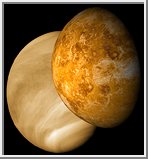 Venus with Visible and Radar Illumination
Venus with Visible and Radar Illumination
This picture shows two different perspectives of Venus. On the left is a mosaic of images acquired by the Mariner 10 spacecraft on February 5, 1974. The image shows the thick cloud coverage that prevents optical observation of the planet's surface. The surface of Venus remained hidden until 1978 when the Pioneer Venus 1 spacecraft arrived and went into orbit about the planet on December 4th. The spacecraft used radar to map planet's surface, revealing a new Venus. Later in August of 1990 the Magellan spacecraft arrived at Venus and began its extensive planetary mapping mission. This mission produced radar images up to 300 meters per pixel in resolution. The right image show a rendering of Venus from the Pioneer Venus and Magellan radar images. (Copyright Calvin J. Hamilton)
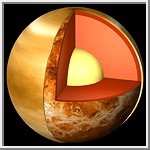 The Interior of Venus
The Interior of Venus
This picture shows a cutaway view of the possible internal structure of Venus. The image was created from Mariner 10 images used for the outer atmospheric layer. The surface was taken from Magellan radar images. The interior characteristics of Venus are inferred from gravity field and magnetic field measurements by Magellan and prior spacecraft. The crust is shown as adark red, the mantle as a lighter orange-red, and the core yellow. More ... (Copyright Calvin J. Hamilton)
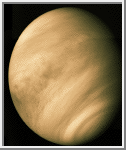 Mariner 10 Image of Venus
Mariner 10 Image of Venus
This beautiful image of Venus is a mosaic of three images acquired by the Mariner 10 spacecraft on February 5, 1974. It shows the thick cloud coverage that prevents optical observation of the surface of Venus. Only through radar mapping is the surface revealed. (Copyright Calvin J. Hamilton)
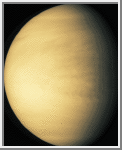 Galileo Image of Venus
Galileo Image of Venus
On February 10, 1990 the Galileo spacecraft acquired this image of Venus. Only thick cloud cover can be seen. (Copyright Calvin J. Hamilton)
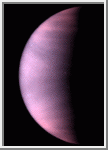 Hubble Image of Venus
Hubble Image of Venus
This is a Hubble Space Telescope ultraviolet-light image of the planet Venus, taken on January 24, 1995, when Venus was at a distance of 113.6 million kilometers from Earth. At ultraviolet wavelengths cloud patterns become distinctive. In particular, a horizontal "Y" shaped cloud feature is visible near the equator. The polar regions are bright, possibly showing a haze of small particles overlying the main clouds. The dark regions show the location of enhanced sulfur dioxide near the cloud tops. From previous missions, astronomers know that such features travel east to west along with the Venus' prevailing winds, to make a complete circuit around the planet in four days. (Credit: L. Esposito, University of Colorado, Boulder, and NASA)
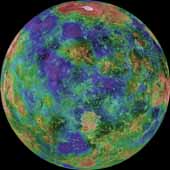 Hemispheric View of Venus
Hemispheric View of Venus
This hemispheric view of Venus, as revealed by more than a decade of radar investigations culminating in the 1990-1994 Magellan mission, is centered at 0 degrees east longitude. The effective resolution of this image is about 3 kilometers. It was processed to improve contrast and to emphasize small features, and was color-coded to represent elevation. (Courtesy NASA/USGS)
Additional Hemispheric Views of Venus
- View centered at 90°E longitude.
- View centered at 180°E longitude.
- View centered at 90°W longitude.
- View centered at the north pole.
- View centered at the south pole.
 Venusian Map
Venusian MapThis image is a Mercator projection of Venusian topography. Many of the different regions have been labeled. The map extends from -66.5 to 66.5 degrees in latitude and starts at 240 degrees longitude. (Copyright Calvin J. Hamilton)
 Venusian Topography Map
Venusian Topography MapThis is another Mercator projection of Venusian topography. The map extends from -66.5 to 66.5 degrees in latitude and starts at 240 degrees longitude. A Black & White version of this image is also available. (Courtesy A.Tayfun Oner)
 Gula Mons and Crater Cunitz
Gula Mons and Crater CunitzA portion of Western Eistla Regio is displayed in this three dimensional perspective view of the surface of Venus. The viewpoint is located 1,310 kilometers (812 miles) southwest of Gula Mons at an elevation of 0.78 kilometers (0.48 mile). The view is to the northeast with Gula Mons appearing on the horizon. Gula Mons, a 3 kilometer (1.86 mile) high volcano, is located at approximately 22 degrees north latitude, 359 degrees east longitude. The impact crater Cunitz, named for the astronomer and mathematician Maria Cunitz, is visible in the center of the image. The crater is 48.5 kilometers (30 miles) in diameter and is 215 kilometers (133 miles) from the viewer's position. (Courtesy NASA/JPL)
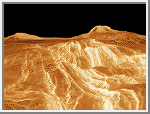 Eistla Regio - Rift Valley
Eistla Regio - Rift ValleyA portion of Western Eistla Regio is displayed in this three dimensional perspective view of the surface of Venus. The viewpoint is located 725 kilometers (450 miles) southeast of Gula Mons. A rift valley, shown in the foreground, extends to the base of Gula Mons, a 3 kilometer (1.86 miles) high volcano. This view is facing the northwest with Gula Mons appearing at the right on the horizon. Sif Mons, a volcano with a diameter of 300 kilometers (180 miles) and a height of 2 kilometers (1.2 miles), appears to the left of Gula Mons in the background. (Courtesy NASA/JPL)
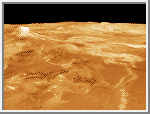 Eistla Regio
Eistla RegioA portion of Western Eistla Regio is displayed in this three dimensional perspective view of the surface of Venus. The viewpoint is located 1,100 kilometers (682 miles) northeast of Gula Mons at an elevation of 7.5 kilometers (4.6 miles). Lava flows extend for hundreds of kilometers across the fractured plains shown in the foreground, to the base of Gula Mons. This view faces the southwest with Gula Mons appearing at the left just below the horizon. Sif Mons appears to the right of Gula Mons. The distance between Sif Mons and Gula Mons is approximately 730 kilometers (453 miles). (Courtesy NASA/JPL)
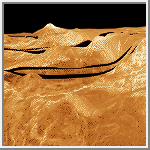 Lakshmi Planum
Lakshmi PlanumThe southern scarp and basin province of western Ishtar Terra are portrayed in this three dimensional perspective view. Western Ishtar Terra is about the size of Australia and is a major focus of Magellan investigations. The highland terrain is centered on a 2.5 km to 4 km high (1.5 mi to 2.5 mi high) plateau called Lakshmi Planum which can be seen in the distance at the right. Here the surface of the plateau drops precipitously into the bounding lowlands, with steep slopes that exceed 5% over 50 km (30 mi). (Courtesy NASA/JPL)
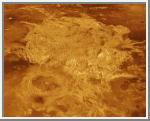 Three-Dimensional Perspective View of Alpha Regio
Three-Dimensional Perspective View of Alpha RegioA portion of Alpha Regio is displayed in this three-dimensional perspective view of the surface of Venus. Alpha Regio, a topographic upland approximately 1300 kilometers across, is centered on 25 degrees south latitude, 4 degrees east longitude. In 1963, Alpha Regio was the first feature on Venus to be identified from earth-based radar. The radar-bright area of Alpha Regio is characterized by multiple sets of intersecting trends of structural features such as ridges, troughs, and flat-floored fault valleys that, together, form a polygonal outline. Directly south of the complex ridged terrain is a large ovoid-shaped feature named Eve. The radar-bright spot located centrally within Eve marks the location of the prime meridian of Venus. (Courtesy NASA/JPL)
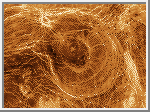 Arachnoids
ArachnoidsArachnoids are one of the more remarkable features found on Venus. They are seen on radar-dark plains in this Magellan image mosaic of the Fortuna region. As the name suggests, arachnoids are circular to ovoid features with concentric rings and a complex network of fractures extending outward. The arachnoids range in size from approximately 50 kilometers (29.9 miles) to 230 kilometers (137.7 miles) in diameter. Arachnoids are similar in form but generally smaller than coronae (circular volcanic structures surrounded by a set of ridges and grooves as well as radial lines). One theory concerning their origin is that they are a precursor to coronae formation. The radar-bright lines extending for many kilometers might have resulted from an upwelling of magma from the interior of the planet which pushed up the surface to form "cracks." Radar-bright lava flows are present in the 1st and 3rd image, also indicative of volcanic activity in this area. Some of the fractures cut across these flows, indicating that the flows occurred before the fractures appeared. Such relations between different structures provide good evidence for relative age dating of events. (Courtesy NASA/JPL)
 Parallel Lines
Parallel LinesTwo groups of parallel features that intersect almost at right angles are visible. The regularity of this terrain caused scientists to nickname it graph paper terrain. The fainter lineations are spaced at intervals of about 1 kilometer (.6 miles) and extend beyond the boundaries of the image. The brighter, more dominant lineations are less regular and often appear to begin and end where they intersect the fainter lineations. It is not yet clear whether the two sets of lineations represent faults or fractures, but in areas outside the image, the bright lineations are associated with pit craters and other volcanic features. (Courtesy Calvin J. Hamilton)
 Surface Photographs from Venera 9 and 10
Surface Photographs from Venera 9 and 10The Soviet Venera 9 and 10 spacecraft were launched on 8 and 14 June 1975, respectively, to do the unprecedented: place landers on the surface of Venus and return images. The Venera 9 Lander (top) touched down on the surface of Venus on October 22, 1975 at 5:13 UT, about 32° S, 291° E with the sun near zenith. It operated for 53 minutes, allowing return of a single image. Venera 9 landed on a slope inclined by about 30 degrees to the horizontal. The white object at the bottom of the image is part of the lander. The distortion is caused by the Venera imaging system. Angular and partly weathered rocks, about 30 to 40 cm across, dominate the landscape, many partly buried in soil. The horizon is visible in the upper left and right corners.
The Venera 10 Lander (bottom) touched down on the surface of Venus on October 25, 1975 at 5:17 UT, about 16° N, 291° E. The Lander was inclined about 8 degrees. It returned this image during the 65 minutes of operation on the surface. The sun was near zenith during this time, and the lighting was similar to that on Earth on an overcast summer day. The objects at the bottom of the image are parts of the spacecraft. The image shows flat slabs of rock, partly covered by fine-grained material, not unlike a volcanic area on Earth. The large slab in the foreground extends over 2 meters across.
 Color Surface Photographs from Venera 13
Color Surface Photographs from Venera 13
On March 1, 1982 the Venera 13 lander touched down on the Venusian surface at 7.5° S, 303° E, east of Phoebe Regio. It was the first Venera mission to include a color TV camera. Venera 13 survived on the surface for 2 hours, 7 minutes, long enough to obtain 14 images. This color panorama was produced using dark blue, green and red filters and has a resolution of 4 to 5 min. Part of the spacecraft is seen at the bottom of the image. Flat rock slabs and soil are visible. The true color is difficult to judge because the Venerian atmosphere filters out blue light. The surface composition is similar to terrestrial basalt. On the ground in the foreground is a camera lens cover. This image is the left half of the Venera 13 photo.
Ford, John P. et al. Guide to Magellan Image Interpretation. JPL Publication 93-24, 1993.
Robinson, Cordula. "Magellan Reveals Venus." Astronomy, 32-41, February 1995.

 Return to Mercury
Return to Mercury  Home to Earth
Home to Earth
Resource: www.solarviews.com/eng/venus.htm








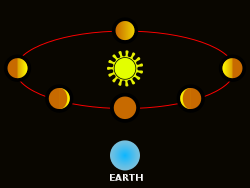

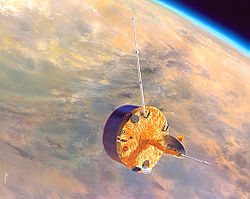





Tidak ada komentar:
Posting Komentar